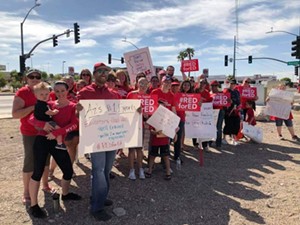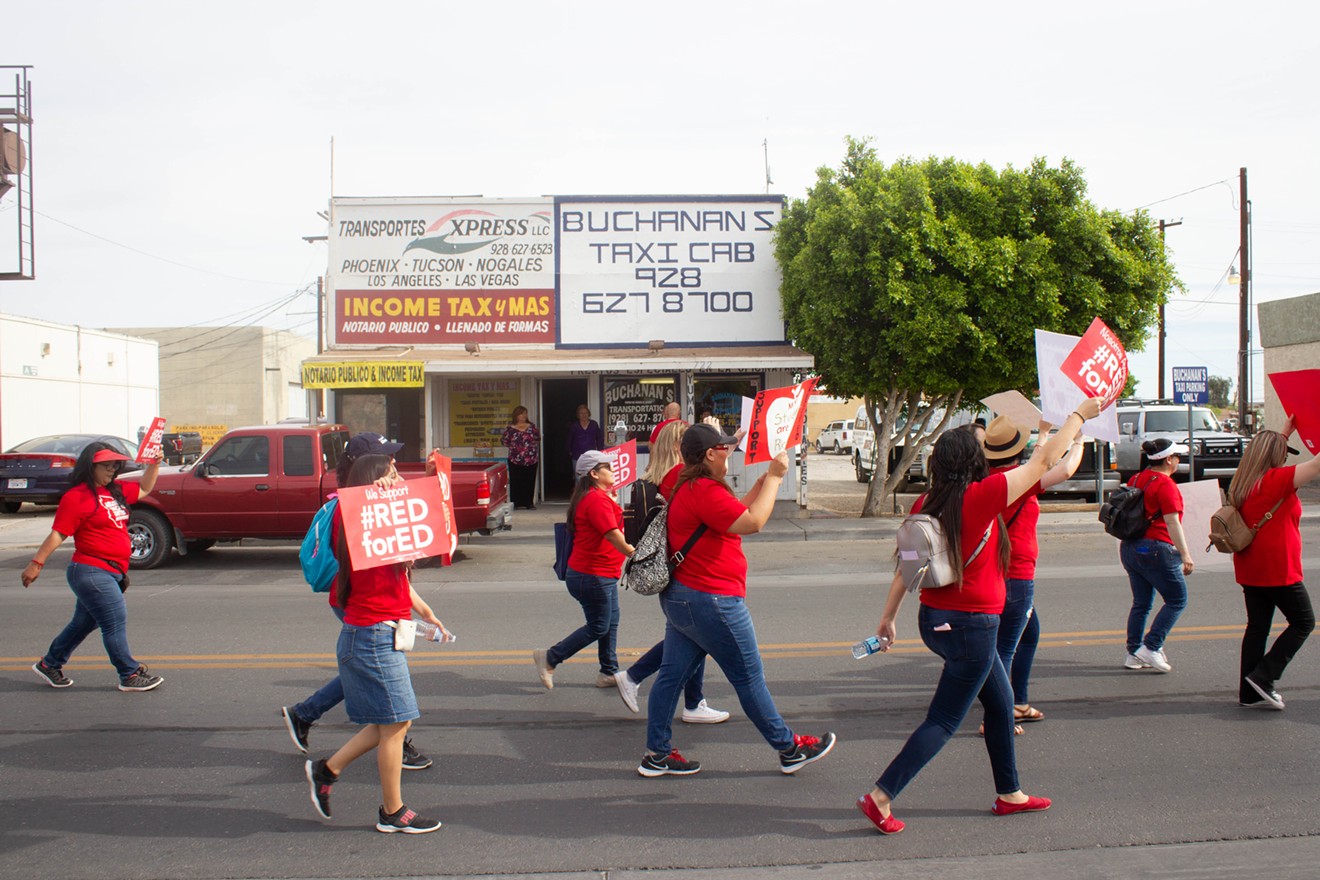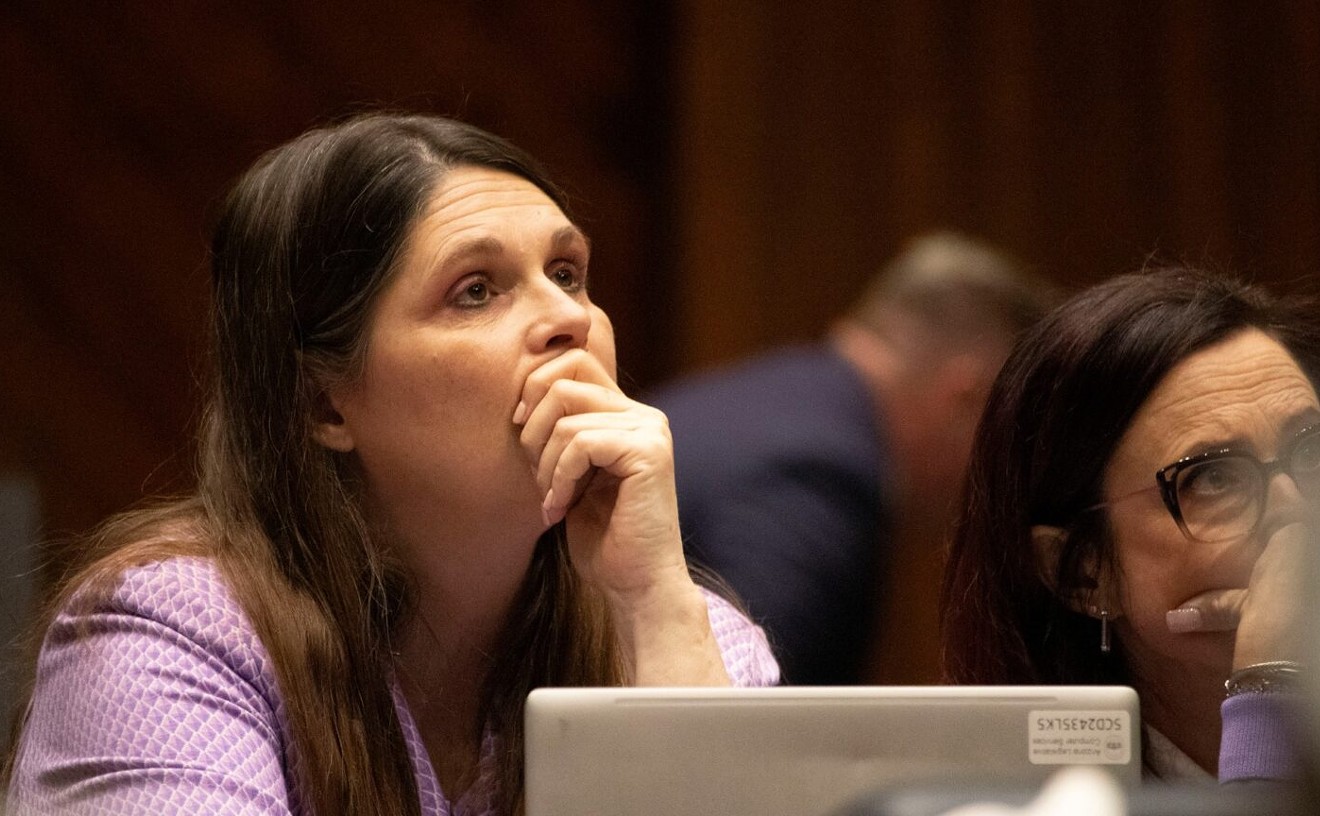Longtime residents struggled to remember the last time that so many people had taken to the streets in this dusty, out-of-the-way border town. It must have been over 20 years ago, they decided, when Chavez died. Though born in nearby Wellton, Chavez had been visiting San Luis when he passed away in 1993, and the town has since named a street, an elementary school, and a cultural center in his honor.
“Our founder is Cesar Chavez — it all started here,” said Luisa Arreola, who teaches language arts at Southwest Junior High School and is the school’s liaison with Arizona Educators United (AEU). “Just like he made a difference for farmers, we want to make that difference for teachers.”
In San Luis, which has a population of about 25,000 and is located 35 minutes south of Yuma, the Gadsden Elementary School District is the single largest employer in town. The economy revolves around agriculture. Most of those jobs are seasonal, leading to a 67 percent unemployment rate. Spanish is the unofficial first language — spoken in 91 percent of homes, according to U.S. Census data — and the town’s newspaper, Bajo El Sol, doesn’t even bother printing an English-language edition.

The statue of Cesar Chavez in San Luis, Arizona, got a new addition during the march.
Antonia Farzan
“What motivated me to come out today was that we just lost five of our best teachers to California because our salaries aren’t competitive,” said Luisa Garcia, who teaches English as a second language at San Luis High School. “This is my hometown, this is where I grew up, and I really want to make a difference, but it’s hard when I need three jobs to be able to support my family.”
The mother of a 4-year-old, Garcia picks up extra money by coaching sports teams, tutoring, and teaching night school, which means that she typically gets to school by 7 a.m. every morning and gets home at 7 p.m. When she was first hired, she made $28,000 a year. Fifteen years later, her salary is only $39,000. Recently, she started studying to get certified to teach in California.
“I really love San Luis High School,” she sighed. “And I would really love to be able to afford to keep teaching here.”
As 50,000 teachers from all over the state were arriving at the Arizona Capitol on Thursday, a much smaller group marched down Main Street in San Luis, passing currency exchanges and department stores catering to Mexican shoppers. When they reached near the customs checkpoint that separates San Luis, Arizona, from San Luis Rio Colorado, Sonora, they turned around. Back at Joe Orduño Park, a handful of teachers heated up the grill and began cooking carne asada for tacos as the temperature hit 99 degrees.

Schools in San Luis continued serving free breakfast and lunch to low-income students during the walkouts.
Antonia Farzan
“We knew they’d have the numbers,” she explained. “We wanted to make an impact here in our community.”
After Arizona teachers voted to go on strike last week, Guzman and Arreola began spending most of their free time getting the mayor, school board, and superintendent on board with the plan. Both are both veteran educators and have grown frustrated with seeing brand-new teachers come to San Luis to get experience, only to soon leave for higher-paying jobs elsewhere once they’ve added few more lines to their resumes. They particularly worry about the impact on students who show up speaking limited English, and need extra help to get up to speed.
“It’s not even about the salaries,” Arreola said. “It’s about the investment in our community. What are we preparing our kids for? Are we preparing them to be the next president, the next mayor?”
At the same time, she understands when teachers tell her that they’re leaving for California, where they’ll make $80,000 a year. After 16 years with the district, she still earns only $36,000 annually, and has taken on several side jobs: tutoring, training new teachers, and teaching two separate drama classes on opposite sides of town.
“When it gets tough," she added matter-of-factly, "I just donate my plasma.”
Rural school districts across Arizona have been hit hard by the teacher shortage, since it can be tough to convince teachers to move to a small town when there may be little financial incentive. But not all have been so quick to come around to the idea of walking out.

Teachers in Bullhead City held a "standout" on Main Street yesterday before returning to their classrooms.
Krissina Marie
“I don’t know if we’d get the full support of the public like Phoenix or Tucson can,” said Joseph Voigt, who teaches economics and government to high school seniors on the San Carlos Apache Reservation.
“In Phoenix or Tucson, teachers are lower-paid members of society. Here, I’m one of the higher-paid people on the reservation. To many of my student’s parents, I’d be looked at as greedy if we closed the school down saying that we need to get more pay.”
Voigt received a 13 percent raise last year, but took most of Thursday off so that he could join the march on the Capitol.
“I’m not complaining so much that I don’t make enough money, but that teachers across the state of Arizona do not make enough money,” he explained. “It’s more the system in general, rather than my specific job.”
San Carlos High School, where he teaches, stayed open on Thursday. Voigt estimated that about half the teachers there come from countries like the Philippines and India and are working on a visa.
"If we get in trouble, that’s a slap on the wrist,” he said. “If they get in trouble, they have to go back to where they’re from."
For that reason, he didn't feel that it was his place to encourage them to walk out.
Due to funding shortfalls, many rural schools open only Monday through Thursday, which allows them to save money on electricity and school buses. That made it easier for some teachers to take part in the walkouts, but most indicated they intended to return on Monday, even though AEU and the Arizona Education Association haven’t set an end date for the strike.
“In communities like ours, the school plays a more central role in the lives of people because there’s no daycare — you have to know people who are running daycare out of their houses,” explained Phillip Brown, who teaches ninth- and 10th-grade math at Rio Rico High School, 15 miles north of the U.S.-Mexico border in hilly Santa Cruz County. “There’s not many social services, no Boys and Girls Club, no YMCA. There’s one park in the whole place.”
To combat some of the initial skepticism about the Red for Ed movement, Brown has been holding after-school information sessions for parents. He’ll explain, for instance, that they’re paying additional taxes because the community voted to pass bonds and overrides in order to compensate for the lack of investment from the state. Or that school-sponsored activities like playing on a sports team used to be free, but now cost hundreds of dollars because the district can’t afford to pay for uniforms, coaches, and travel.
But he feels that there’s more work to be done before the general public will support an extended strike.
“They see the upheaval, they see the governor offered a 20 percent raise, and they don’t see what the problem is,” he said. “We’re not going to get them to understand with a strike. The potential for fallout is very high.”
Even in small towns where word typically travels fast, teachers in rural districts report that the isolated and occasionally insular nature of their communities means that it’s taken them longer to get momentum going.
“There’s a lot of fear among people, and a lot of worry about reprisals because we don’t have the options for employment that you have in a larger area,” said Susan Collins, who teaches music at Manzanita Elementary in the high desert railroad town of Kingman. “If you lose your job with the school, where else are you going to work?”
Some small-town educators also worry that going on strike could lead to a rift with their neighbors. As Caty Salazar, a special education teacher in Eagar (population: 4,885) puts it: “We live by all the people in our community. It’s not a big area, where you drive 30 minutes to another district. You see everybody in the grocery store.”
But being in a rural area does come with one major advantage.
“There’s a huge amount of support, and I think it’s because in a small town everybody knows everybody,” Collins, the Kingman elementary school teacher, said. “Everybody is either related to a teacher, knows a teacher, or has a kid that gets a supply list that’s horrendously large at the start of the school year.”
In Kingman, parents often end up supplying the hand soap and paper towels that get used in school bathrooms, Collins said. Her school holds a copy paper drive once a month where kids get a reward — usually an out-of-uniform day — if they bring in a ream of copy paper. So to anyone with a school-age kid, the news that Arizona schools need more money comes as no surprise.

The San Luis Police Department estimated that over 200 marchers had turned out on Thursday.
Antonia Farzan
But the plan of many rural teachers to return to work on Monday — if they even walked out in the first place — raises questions about whether #RedForEd is truly a statewide movement.
Some small-town teachers have already complained about feeling left out; others simply lack the resources and infrastructure to ensure that low-income students will be fed and supervised while their schools are closed.
But there’s no reason to assume that the movement is doomed to fail in geographically isolated areas, either. San Luis is proof of that. Teachers there report getting virtually no pushback from parents, although, in this case, the town’s high seasonal unemployment rate may have worked in their favor.
“The season is over,” said Selene Arredondo, a language arts teacher at Southwest Junior High. “The majority of my kids’ parents are home. Or they’ve gone back to California.”
Alejandro Navarro, a construction worker in San Luis, was initially confused when he received a letter saying that school was cancelled for the next two days. His 13-year-old son had spent the day at home alone, he said, “probably on his phone or something.”
“I think that’s pretty sad that my kid is not going to school for two days, and maybe more,” he said, leaning against a wrought-iron fence on Cesar Chavez Street, where he’d just dropped off a coworker on his way home from work.
Once he learned why teachers were protesting, though, he didn’t begrudge them. “They gotta live, they gotta support their families too,” he said. “They deserve it.”












